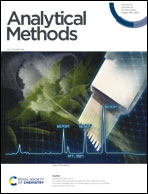A non-lethal SPME-LC/MS method for the analysis of plastic-associated contaminants in coral reef invertebrates†
Abstract
Current approaches to evaluate microplastic contamination of the marine environment include the use of marine organisms as bioindicators and the detection of plastic-associated contaminants in their tissues. Liquid/liquid extraction and/or solid-phase extraction are the usual methods of choice for sample preparation. However, these methods suffer from background contamination, due to the large volume of solvents used and the ubiquity of plasticizers in laboratory environments. Moreover, organisms used in the study may belong to species that are rare or endangered and these should preferably not be sacrificed as a consequence of the relatively sizeable biological material required for exhaustive sample extractions and the destructive nature of mass spectrometry analysis. In this study, we evaluated, as a non-lethal alternative, a procedure involving solid phase microextraction (SPME) coupled with liquid chromatography mass spectrometry (LC/MS) analysis. Two coral reef invertebrates that may be sensitive to microplastic contamination were used for the tests, i.e., the scleractinian Danafungia scruposa and the bivalve mollusk Tridacna maxima. The results showed that the method was effective in quantifying phthalate esters within ten minutes of exposure, offering at the same time an improved control of the background contamination compared to the classical extraction procedure.



 Please wait while we load your content...
Please wait while we load your content...